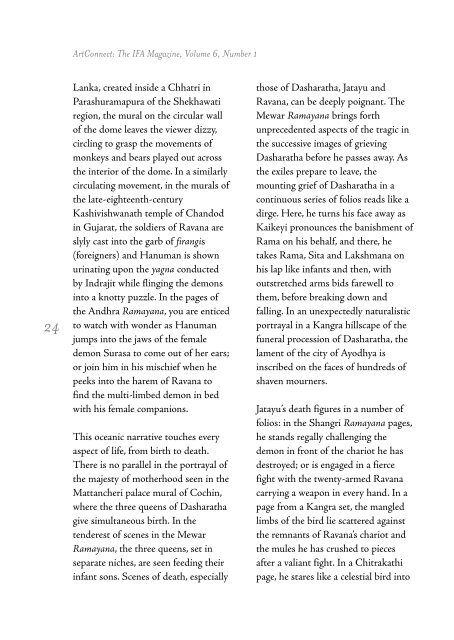Layout 3 - India Foundation for the Arts - IFA
Layout 3 - India Foundation for the Arts - IFA
Layout 3 - India Foundation for the Arts - IFA
You also want an ePaper? Increase the reach of your titles
YUMPU automatically turns print PDFs into web optimized ePapers that Google loves.
24<br />
ArtConnect: The <strong>IFA</strong> Magazine, Volume 6, Number 1<br />
Lanka, created inside a Chhatri in<br />
Parashuramapura of <strong>the</strong> Shekhawati<br />
region, <strong>the</strong> mural on <strong>the</strong> circular wall<br />
of <strong>the</strong> dome leaves <strong>the</strong> viewer dizzy,<br />
circling to grasp <strong>the</strong> movements of<br />
monkeys and bears played out across<br />
<strong>the</strong> interior of <strong>the</strong> dome. In a similarly<br />
circulating movement, in <strong>the</strong> murals of<br />
<strong>the</strong> late-eighteenth-century<br />
Kashivishwanath temple of Chandod<br />
in Gujarat, <strong>the</strong> soldiers of Ravana are<br />
slyly cast into <strong>the</strong> garb of firangis<br />
(<strong>for</strong>eigners) and Hanuman is shown<br />
urinating upon <strong>the</strong> yagna conducted<br />
by Indrajit while flinging <strong>the</strong> demons<br />
into a knotty puzzle. In <strong>the</strong> pages of<br />
<strong>the</strong> Andhra Ramayana, you are enticed<br />
to watch with wonder as Hanuman<br />
jumps into <strong>the</strong> jaws of <strong>the</strong> female<br />
demon Surasa to come out of her ears;<br />
or join him in his mischief when he<br />
peeks into <strong>the</strong> harem of Ravana to<br />
find <strong>the</strong> multi-limbed demon in bed<br />
with his female companions.<br />
This oceanic narrative touches every<br />
aspect of life, from birth to death.<br />
There is no parallel in <strong>the</strong> portrayal of<br />
<strong>the</strong> majesty of mo<strong>the</strong>rhood seen in <strong>the</strong><br />
Mattancheri palace mural of Cochin,<br />
where <strong>the</strong> three queens of Dasharatha<br />
give simultaneous birth. In <strong>the</strong><br />
tenderest of scenes in <strong>the</strong> Mewar<br />
Ramayana, <strong>the</strong> three queens, set in<br />
separate niches, are seen feeding <strong>the</strong>ir<br />
infant sons. Scenes of death, especially<br />
those of Dasharatha, Jatayu and<br />
Ravana, can be deeply poignant. The<br />
Mewar Ramayana brings <strong>for</strong>th<br />
unprecedented aspects of <strong>the</strong> tragic in<br />
<strong>the</strong> successive images of grieving<br />
Dasharatha be<strong>for</strong>e he passes away. As<br />
<strong>the</strong> exiles prepare to leave, <strong>the</strong><br />
mounting grief of Dasharatha in a<br />
continuous series of folios reads like a<br />
dirge. Here, he turns his face away as<br />
Kaikeyi pronounces <strong>the</strong> banishment of<br />
Rama on his behalf, and <strong>the</strong>re, he<br />
takes Rama, Sita and Lakshmana on<br />
his lap like infants and <strong>the</strong>n, with<br />
outstretched arms bids farewell to<br />
<strong>the</strong>m, be<strong>for</strong>e breaking down and<br />
falling. In an unexpectedly naturalistic<br />
portrayal in a Kangra hillscape of <strong>the</strong><br />
funeral procession of Dasharatha, <strong>the</strong><br />
lament of <strong>the</strong> city of Ayodhya is<br />
inscribed on <strong>the</strong> faces of hundreds of<br />
shaven mourners.<br />
Jatayu’s death figures in a number of<br />
folios: in <strong>the</strong> Shangri Ramayana pages,<br />
he stands regally challenging <strong>the</strong><br />
demon in front of <strong>the</strong> chariot he has<br />
destroyed; or is engaged in a fierce<br />
fight with <strong>the</strong> twenty-armed Ravana<br />
carrying a weapon in every hand. In a<br />
page from a Kangra set, <strong>the</strong> mangled<br />
limbs of <strong>the</strong> bird lie scattered against<br />
<strong>the</strong> remnants of Ravana’s chariot and<br />
<strong>the</strong> mules he has crushed to pieces<br />
after a valiant fight. In a Chitrakathi<br />
page, he stares like a celestial bird into


